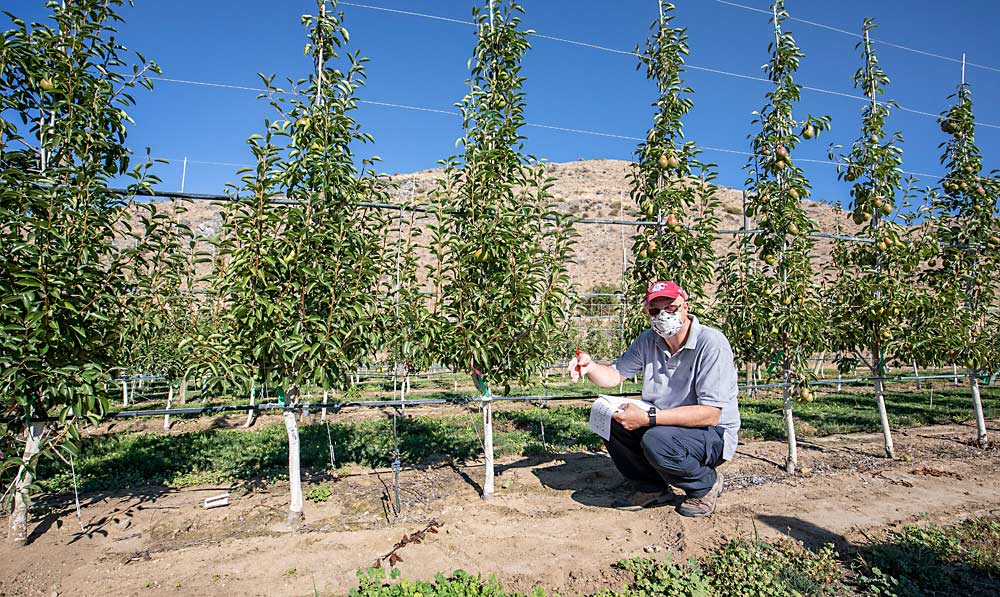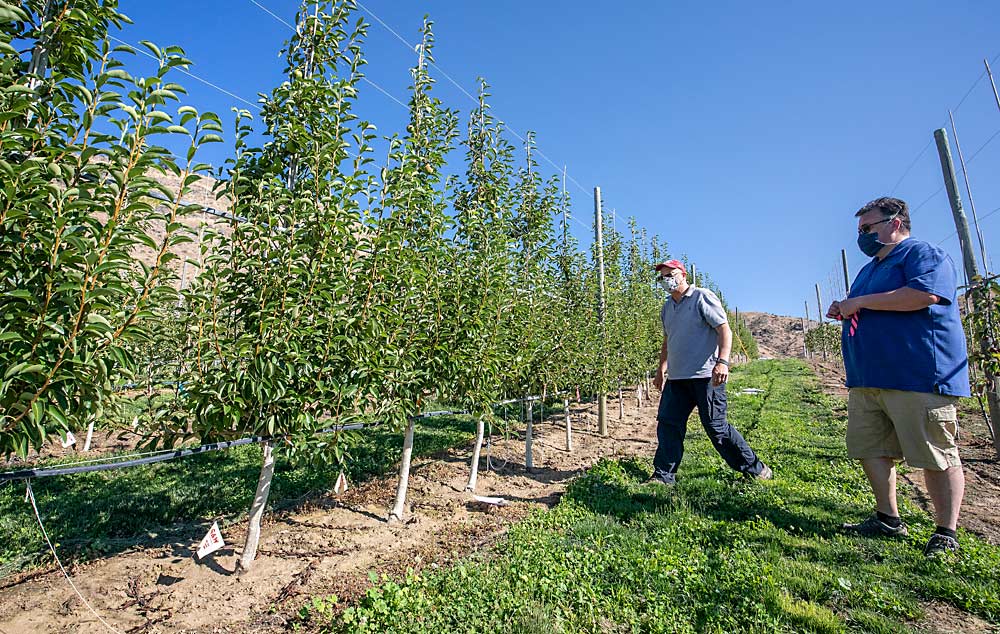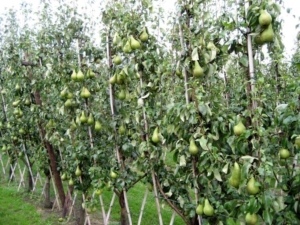
U.S. pear growers have waited decades to follow the path of apples and grow fruit on size-controlling rootstocks planted at higher densities. Breeding programs are in the midst of developing dwarfing rootstocks for pear, but they might not be available for another 25 to 30 years.
In the meantime, quince rootstocks, which are very popular in Europe, might be the medium-term solution, said Stefano Musacchi, endowed chair for tree fruit physiology at Washington State University.
With Todd Einhorn, a former Oregon State University tree fruit physiologist now at Michigan State University, Musacchi planted quince rootstocks in 2017 trials to evaluate suitability for use in the Pacific Northwest.
They selected nine quince accessions that offered fire blight resistance and cold hardiness and planted them for observation at two sites — in Parkdale, Oregon, and near Chelan, Washington. Definitive results are still several years away, but they’re looking closely at compatibility issues, vigor and production. The most successful accessions will move on to the next phase of the trials.
In late July, Musacchi did a video walk-through of the Washington test block for a virtual field day, making observations about the different accessions of quince grafted with Bartlett and Anjou. Some trees were grafted directly but most have an interstem with the Comice variety.
At planting, the nursery trees were not very uniform, so Musacchi used click pruning techniques to start them over and develop the spindle structure common in Europe. The trees, planted at 3 feet by 12 feet, have strong scaffolds at the bottom and short branches going up.
Quince usually grows large fruit and is relatively precocious. It’s easy to propagate, and its superficial root system means it starts early in spring and ripens early. But quince can be incompatible with popular varieties such as Bartlett and Anjou, and it struggles in the colder growing regions of the northern United States. Using an interstem such as Comice can relieve incompatibility but adds complications, such as lengthening the time it takes to grow a tree in the nursery, Musacchi said.
Think of incompatibility like a tap on a faucet, he said. If it’s perfectly compatible, it’s like an open faucet and the trees can have too much vigor. If it’s totally closed, the tree will die. But in between there’s a sweet spot of control for optimum high-density performance. That’s what he’s looking for in the vigor of the trees.

Several of the accessions in the trial clearly struggled — that’s good to know, Musacchi said. He wants to weed out most and just recommend the best performers for precommercial trials in the next few years. Here are some of Musacchi’s observations on the quince accessions at the Washington trial:
—99.002. Bartlett is growing very well on the direct graft, but Musacchi is concerned about long-term vigor balance. He prefers the balanced vigor he sees on the Bartlett connected to 99.002 with the Comice interstem.
—22.001. Good vigor with dark green leaves. Great potential for cropping the following year.
—65.001. More fruit compared to the others, but a bit less vigor. The trees appear healthy. One of their best options right now. Worked well with both Anjou and Bartlett.
—57.001. A bit more vigorous. Great potential for loading fruit the next year.
—23.001. Intermediate vigor. Probably needs more nitrogen. Graft incompatibility needs to be studied more.
Full review of rootstock trial
Available rootstocks
For pear growers who want to plant trees now, Einhorn recommended the OHxF 87 rootstock “hands down.” Spacing depends on cultivar, site and management techniques, but in the Pacific Northwest, a 4- by 12-feet spacing (908 trees per acre) is possible with Bartlett. He’s seen 4 by 12 work for Anjou in an upright V or central leader system, but success requires eliminating big wood and getting branches to 30- to 45-degree angles above horizontal.
Einhorn provided brief descriptions of commercial rootstocks currently available in the U.S.:
—OHxF 87. The most precocious and dwarfing Pyrus rootstock in U.S. production. Trees are approximately 70 percent of seedling rootstock size. May not perform as well in hot climates.
—OHxF 97. Slightly greater vigor and less precocity than 87. A good selection for sandy and/or weaker soils. Well suited to cultivars with reduced vigor such as Red Anjou.
—Pyro 2-33. Appears to produce canopies of similar size and productivity as OHxF 87.
—OHxF 69. More vigorous than 87. Propagation from cuttings is difficult, and more recent commercial production is primarily from tissue culture.
—Quince MA or A. Precocious and productive but has borderline cold hardiness for northern U.S. regions. Known to be sensitive to high pH soils. Limited availability in the U.S.
—BA-29C. Also known as Provence Quince, this rootstock is more vigorous than Quince A and lacks sufficient hardiness for northern U.S. regions. It is sensitive to high pH soils (chlorosis) and fire blight and has incompatibility issues with several scions.
—Quince Eline. Relatively new rootstock from Romania. Borderline hardiness for northern U.S. regions. Likely requires an interstem. Gaining acceptance in Europe. Unknown virus status.
—Amelanchier (A15). This highly dwarfing and very precocious rootstock is also extremely cold hardy. It’s in the early phases of evaluation with limited small-scale commercial testing. May have challenges filling canopy volume and likely requires an interstem for most cultivars. Fruit size is large. •
—by Matt Milkovich







Leave A Comment